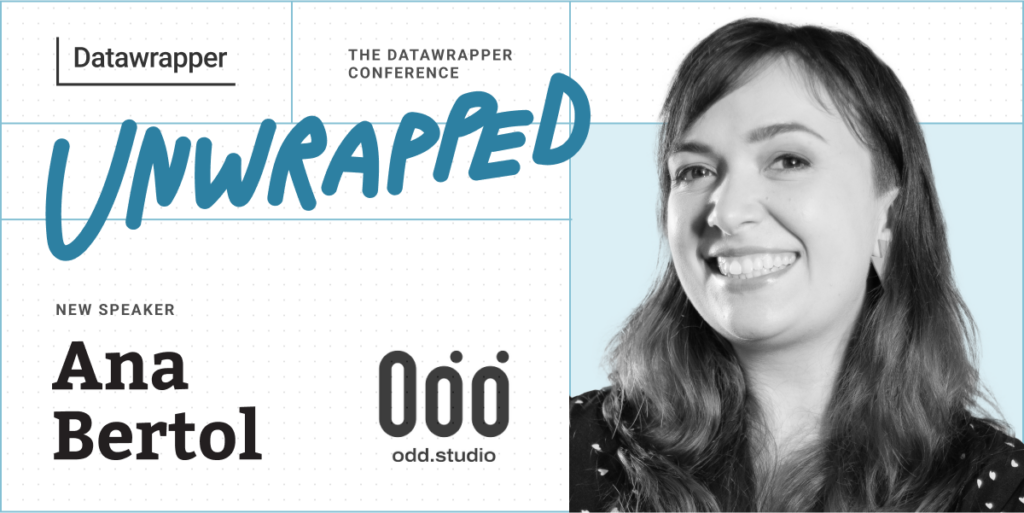Watch the recordings of Unwrapped, our conference
August 12th, 2024
5 min
Datawrapper lets you show your data as beautiful charts, maps or tables with a few clicks. Find out more about all the available visualization types.
Our mission is to help everyone communicate with data - from newsrooms to global enterprises, non-profits or public service.
We want to enable everyone to create beautiful charts, maps, and tables. New to data visualization? Or do you have specific questions about us? You'll find all the answers here.
Data vis best practices, news, and examples
250+ articles that explain how to use Datawrapper
Answers to common questions
An exchange place for Datawrapper visualizations
Attend and watch how to use Datawrapper best
Learn about available positions on our team
Our latest small and big improvements
Build your integration with Datawrapper's API
Get in touch with us – we're happy to help

We’re excited to announce that Ana Bertol from Odd Data & Design Studio will speak at our Unwrapped conference about “Helping scientists make their data speak with Datawrapper.”
Ana is a data leader at Odd Data & Design Studio, a Spain- and Brazil-based information design studio. She holds a Doctorate in Physics and has experience as a data scientist and data translator. She has recently discovered her passion for Datawrapper while training researchers from various fields in data storytelling to drive change with their scientific discoveries.
Time to ask her some questions:
Scientists, how can you not love them? Their curiosity, passion, intelligence… and dreadful data visualizations. Don’t worry: 13 years as a researcher and 6 more in dataviz allow me this kind of joke. But how can we assist them in communicating their research to broader audiences without burdening them with learning another expertise? Well, with Datawrapper’s foolproof charts.
In the knowledge translation project with the nutrition research group at the University of São Paulo (USP), Brazil, Datawrapper was crucial in training researchers to create beautiful, clear, and engaging visualizations tailored for their target audience. Through the team functionality, we were able to combine our graphic design and data storytelling expertise with the researchers’ knowledge, working iteratively and accelerating their learning curve while still co-creating. You can learn more about the project in Portuguese here.
The visualization below was built together with a research team from USP Brazil. It shows the decline in beans and fruit consumption, while other less-healthy ultra-processed foods are experiencing a rise:
I like this visualization because it demonstrates the versatility of Datawrapper. Slope charts are not a predefined chart type, but they can easily be created using line charts. This chart is part of this data story (in Portugese) about the importance of monitoring the nutritional habits of the population in the public health system.
Teaching data visualization often faces the tool barrier: the beginner thinks that everything you are teaching is either talent or tool-dependent, thus is far from their reach. When we start teaching a lot of tips about labels, titles, annotations, grid lines, they just feel like it's something impossible. With Datawrapper, I can focus on teaching them how the same dataset can tell different stories with different choices and use Datawrapper as an easy tool for them to test these choices, regardless of other design options that can overwhelm them: font size, title position, margins, and more.
Annotations, without a doubt. I love the power of text and visual annotations on charts, and this is one of the main tips I give beginning practitioners. Datawrapper is probably the easiest tool to add many types of annotations, in a way that is always beautiful and adaptable to different screens. Screen adaptability is also one of my favorites!
As someone with a more technical background, I tend to dive into the data and focus on what it allows me to do (or not). However, this is not the most important thing when creating a data visualization: the message is. So, one approach I've been trying to apply is to explicitly write a phrase that can substitute the chart – something like an alt text. Visually representing this message becomes the success metric of my data visualization.
We're looking forward to Ana's talk at Unwrapped! Until then, you can find more about her on LinkedIn, and learn about Odd Studio on Instagram or their website. To sign up for Unwrapped and hear Ana and other great speakers, visit our conference website.
Comments